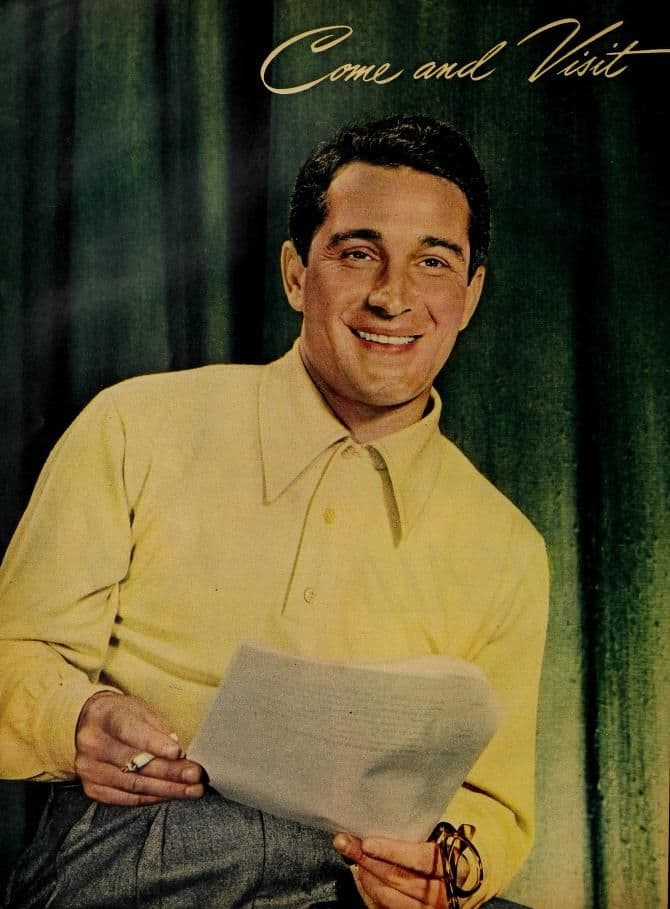
A Celestial Warning: When Love’s Gaze Blinds You to Reality
Ah, the gentle lilt of a simpler time, isn’t it? When a crooner’s voice could transport you to a world of hushed romance and bittersweet contemplation. And few voices did that quite like Perry Como. Tonight, let’s cast our minds back to 1952, a year when the world was still finding its footing after the war, and hearts, perhaps, were a little more open, a little more susceptible to the kind of tender wisdom found in a song like “Don’t Let the Stars Get in Your Eyes.”
This wasn’t just any tune; it was a phenomenon. Perry Como’s rendition soared, reaching an impressive number one on the Billboard charts, a testament to its immediate and widespread appeal. Imagine the scene: families gathered around their radios, the soft glow of a tube illuminating faces as Como’s smooth baritone filled the room. It wasn’t just a song; it was a moment, a shared experience for millions across America and beyond.
But what truly made “Don’t Let the Stars Get in Your Eyes” resonate so deeply? Its origins are fascinating, a story of evolving interpretations and a gentle tug-of-war between country and pop. The song itself was penned by Slim Willet, a country musician who first recorded it in 1952. Willet’s version, steeped in the melancholic twang of traditional country, also found its own success, reaching number one on the country charts. However, it was Como’s polished, orchestral arrangement that truly catapulted it into the mainstream consciousness, softening the edges of its rural roots and making it palatable for a broader audience.
The meaning behind the song, though seemingly straightforward, holds a profound depth that speaks to the timeless human condition. At its core, “Don’t Let the Stars Get in Your Eyes” is a cautionary tale, a gentle admonition to those swept up in the intoxicating rush of new love. It warns against being so utterly captivated, so completely smitten by another person’s charm and allure, that you fail to see their true nature, their flaws, or even their genuine intentions. The “stars” here are not just literal celestial bodies, but a beautiful metaphor for the dazzling, almost blinding, enchantment that love can cast upon us. It speaks to the idealization that often accompanies infatuation, the tendency to project our desires and fantasies onto the beloved, rather than seeing them as they truly are.
Consider the gentle plea in Como’s voice as he sings of avoiding a love that might ultimately lead to heartbreak. It’s not a cynical dismissal of love, but rather a wise suggestion to approach it with a measure of discernment, to keep one’s feet on the ground even as one’s heart takes flight. For us, the “older readers” perhaps, this sentiment resonates even more deeply. We’ve likely experienced the dizzying heights of infatuation, and perhaps, the subsequent crashing lows when reality eventually intrudes. This song, then, becomes a comforting echo of lessons learned, a reminder of the delicate balance between passion and prudence.
Beyond its lyrical message, the arrangement itself contributes immensely to the song’s reflective quality. Como’s delivery is understated, never histrionic, allowing the melody and the lyrics to breathe. The lush instrumentation, characteristic of the era, creates an almost dreamlike atmosphere, perfectly complementing the song’s theme of starry-eyed enchantment. It’s the kind of song that encourages a quiet moment of introspection, a gentle sigh as memories, both sweet and perhaps a little painful, drift to the surface. It’s a reminder that while love is a powerful force, a little caution, a little clarity, can go a long way in navigating its often-tumultuous waters. And in Perry Como’s capable hands, that timeless message felt not like a lecture, but a comforting whisper from a trusted friend.